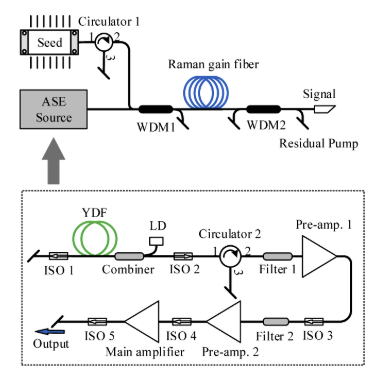Recently, researchers from Shanghai Institute of Optics and Fine Mechanics (SIOM) of the Chinese Academy of Sciences (CAS) have made new progress in the field of single-frequency Raman fiber amplifiers. Due to the relatively lower intensity noise of ASE sources compared to usual fiber laser pumps, the full width at half maximum (FWHM) linewidth of the signal laser increases negligibly. But there is significant increase in RIN and spectral wings due to the noise transfer at high frequency from the ASE source during the Raman amplification.
This research provides a new idea of co-pumping single-frequency Raman amplifiers. The relevant result was published in Optics Expresson May 10, 2021.
Special wavelength single-frequency high-power fiber lasers have a wide range of applications in the fields of astronomy, geophysics, and quantum information technology. Raman fiber amplifier (RFA) technology is an effective approach to obtain these high-power special wavelength lasers. Counter-pumped manner traditionally used in RFAs has a complicated structure and the power increase is limited by stimulated Brillouin scattering and related high-power devices. The co- pumping manner can overcome these shortcomings.
However, in co-pumping RFAs, the noise characteristics of the pump laser are easily transferred to the signal laser, which causes the linewidth of the signal light to broaden.
For this reason, researchers have proposed a method of single-frequency Raman amplifier co-pumped by a low-noise ASE source.
In the experiment, the ASE seed source with a center wavelength of 1065 nm was amplified through three amplifiers to obtain a power output of 20 W. The seed laser is a single frequency diode laser with a central wavelength of 1122 nm and an output power of 10 mW. The ASE source and the seed laser is delivered into a co-pumped RFA after a wavelength division multiplexer. The noise characteristics of the ASE source were tested in detail, and it was found that the ASE source with a full width at half maximum of 10 nm has lower RIN noise than which of 3 nm. It is further found that the 10nm ASE source can achieve linewidth retention characteristics when amplifying the 1122nm single-frequency laser source, but the relative intensity noise of the signal light is significantly improved, which is closely related to the magnification of the co-pumped Raman amplifier. If the spectral width, noise characteristics and power of the ASE source are further optimized, it is expected to achieve lower noise and higher power single-frequency laser amplification.
The research was supported by the National Key R&D Program of China); National Natural Science Foundation of China.

Fig. 1. Schematic of the single-frequency RFA in co-pumping configuration. (Image by SIOM)

Fig. 2. Output spectra of the co-pumped RFAs at different powers: pumped with ASE source of 10-nm linewidth. (Image by SIOM)

Fig. 3. The RIN spectra of the RFA co-pumped by the ASE sources with the linewidth of 10 nm. (Image by SIOM)
Article website:
https://doi.org/10.1364/OE.424063
Contact:
WU Xiufeng
General Administrative Office
Shanghai Institute of Optics and Fine Mechanics, CAS
Email: xfwu@siom.ac.cn
Web: http://english.siom.cas.cn/